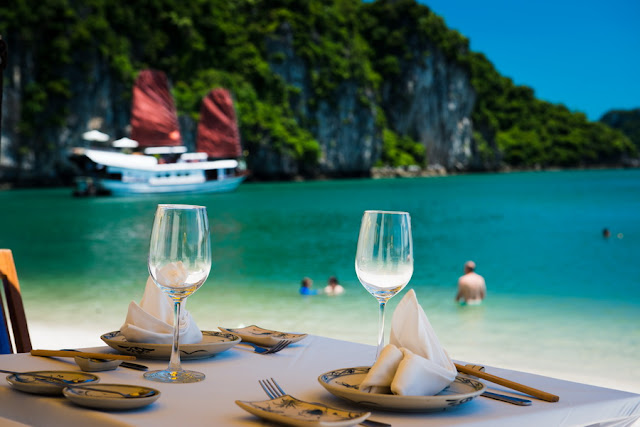After traveling many
times around the world there are few places that take my breath
away and send a nice warm chill down my spine.
Ha Long Bay is one of the marvels that continues to do so. It’s no wonder that countless movies have
filmed in this idyllic location. This is
nature at its finest. Mysterious. Dreamy.
Miraculous.
Deserted beaches & coves abound
Formed 500 million years
ago, this magical bay has nearly two thousand dramatic small limestone islands in varying shapes and
sizes. Many are jaggedly topped with a verdant
rainbow of tropical trees cascading down to deserted tiny beaches and sun-kissed
coves. Formed by millenniums of a
tropical wet climate eroding the limestone mainland, these mystic islands have
broken away from the continental land
mass and have taken with them Vietnam’s flora, fauna, and magnificence. Several
of the islands are hollow with enormous caves that have yet-to-be discovered by
tourists.
Ha Long Bay is northern
Vietnam’s most popular tourism site.
People from all over the country (and for that matter, from all over
Asia) come here…many for honeymoons. In
spite of its mind-boggling number of visitors, Ha Long can offer a tranquil and
romantic experience away from crowds. For example, within
20 minutes of leaving the mainland on a private boat an enormous assortment of private
inlets with secluded shores await anyone who wants to escape. Of the thousands of islands, only 40 are
inhabited. That means endless enchanting
opportunities for privacy-seekers in dream-like
settings.
Ha Long means “dragon” in
Vietnamese. Dragons are considered
protectors in the Vietnamese culture. According to folk-lore, when Vietnam was just
starting to develop as a country it had to fight against multiple
invaders. To assist in the fight, the
gods sent a family of dragons as protectors.
Today, Ha Long Bay and all of its islands are protected by another entity. UNESCO, the United Nation’s World Heritage preservation
arm, safeguards the entire area.
Stringent rules have been enacted to protect everything and ensure that
it remains pristine for future generations.
WineKnows has leased a private yacht for its 2020 tour
WineKnows has leased a
private yacht and will be spending two nights on Ha Long Bay as part of our
tour to Vietnam in February 2020. We
have a few seats remaining. Come enjoy the
exotic beauty of this very special spot with us. http://www.wineknowstravel.com/itinerary-vietnam/







